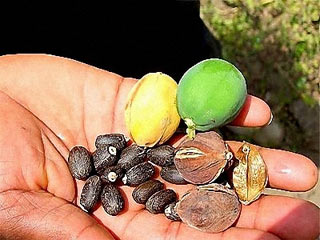Planting sesame oil to collect biofuel
A research group of Plant Cell Technology Department - Institute of Tropical Biology (HCMC) is experimenting with planting jatropha to produce biofuel. Each hectare of jatropha can be processed into 2,500 - 3,000 liters of biodiesel oil per year.
The above research topic was published on September 26.
After conducting trial planting in Binh Phuoc province, the research team found that Jatropha curcas L. is a promising bioenergy plant in Vietnam.
Vietnam has met many conditions to develop jatropha. In tropical soil and climate conditions, jatropha can grow fast, and begin to produce fruits after planting from 6 to 12 months.

If dark extracts, 3 - 3.5 kg of sesame seed oil can produce 1 liter of biodiesel.In the photo: Jatropha and seeds (Photo: Diligent-tanzania.com)
Oil content of sesame seed oil is about 35-40%, so the oil yield of the plant is very high, from 2,500 - 3,000 liters of biodiesel / ha / year. According to the research team, biodiesel production technology after pressing oil from sesame seed oil is relatively simple. Chemicals such as methanol and potassium hydroxyde are the two basic chemicals for biodiesel production from sesame oil that can be purchased in the market easily and cheaply.
This species is drought tolerant, can be grown on barren lands, coastal sandy soil, along roads, land along canal banks along streams. In addition, trees protect good soil and prevent erosion on sloping land. This is an old shrub, once planted can live for 30-40 years.
Sesame oil residue is the raw material to produce organic fertilizer because it contains protein and some pest control compounds.
Jatropha curcas L is known as Jatropha curcas L , originating from Africa, North America and the Caribbean. The tree has a bush form, live in a perennial, can be as high as 5m, but in production it is often used for height of less than 2m for convenient collection.
Jatropha can be propagated by seeds or by cuttings. Trees can grow and develop in places with a height of 0-500m above the sea level, on bad and dry areas with a rainfall of 300mm / year or more. The fruit has three inner compartments containing oval seeds, black, 2 × 1cm in size, and can be easily removed when dried.
Sand incense
- Sesame seeds - taste medicine
- Irradiation to create new sesame seeds
- The reason for using sesame oil
- Hanoi shows off the brilliant yellow season of sesame and leaves
- Medicine taste from sesame buds
- Ho Guom lake is beautiful and charming with the season of sesame and leaves
- Breakthrough in using black sesame treatment compound
- Overview of biofuels
- Lemongrass planting techniques are convenient for every home
- New equipment turns breath into biofuel
- Converting waste cooking oil into biofuel
- Superfuel transport trial biofuel
 Why do potatoes have eyes?
Why do potatoes have eyes? 'Tragedy' the world's largest carnivorous life: Death becomes ... public toilet
'Tragedy' the world's largest carnivorous life: Death becomes ... public toilet Tomatoes were once considered 'poisonous' for 200 years
Tomatoes were once considered 'poisonous' for 200 years Detecting microscopic parasites on human face
Detecting microscopic parasites on human face